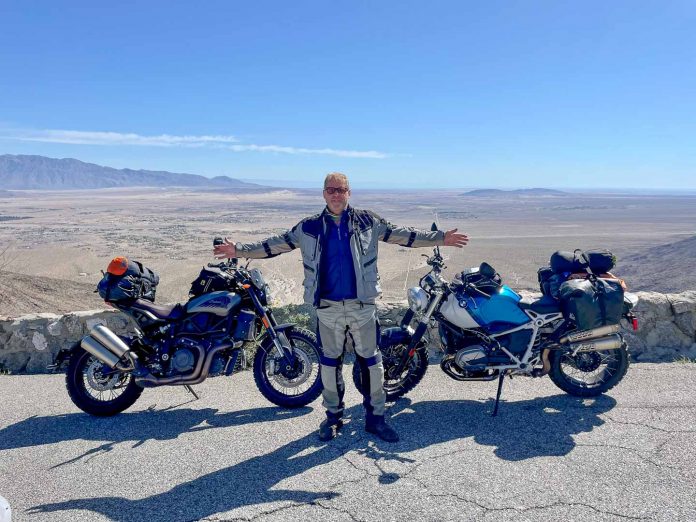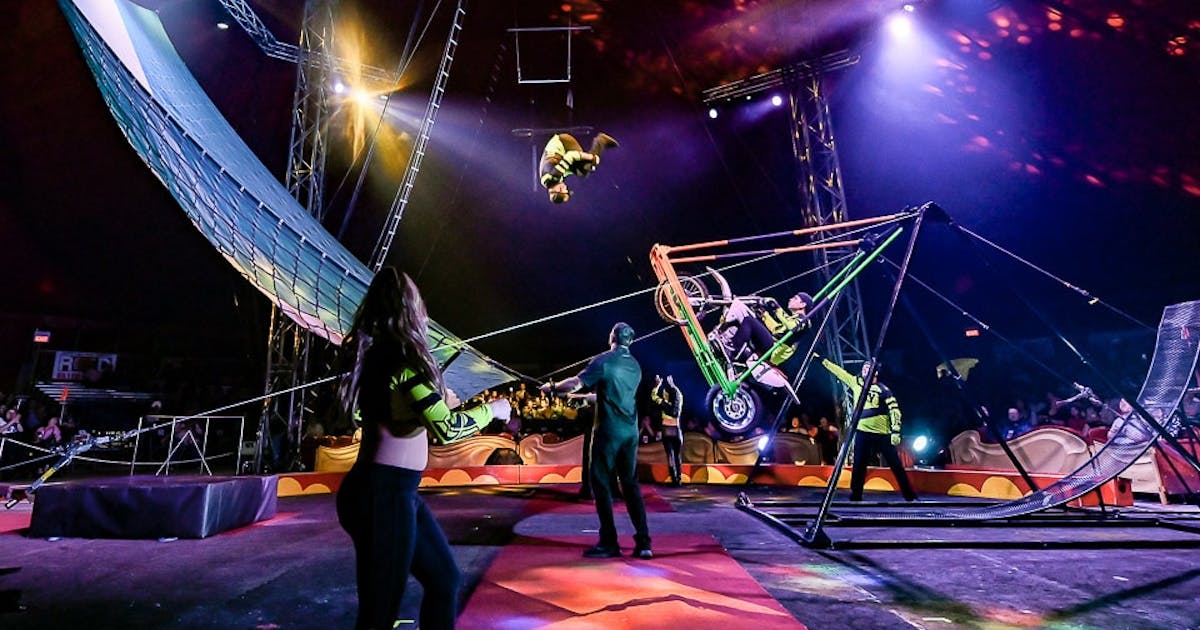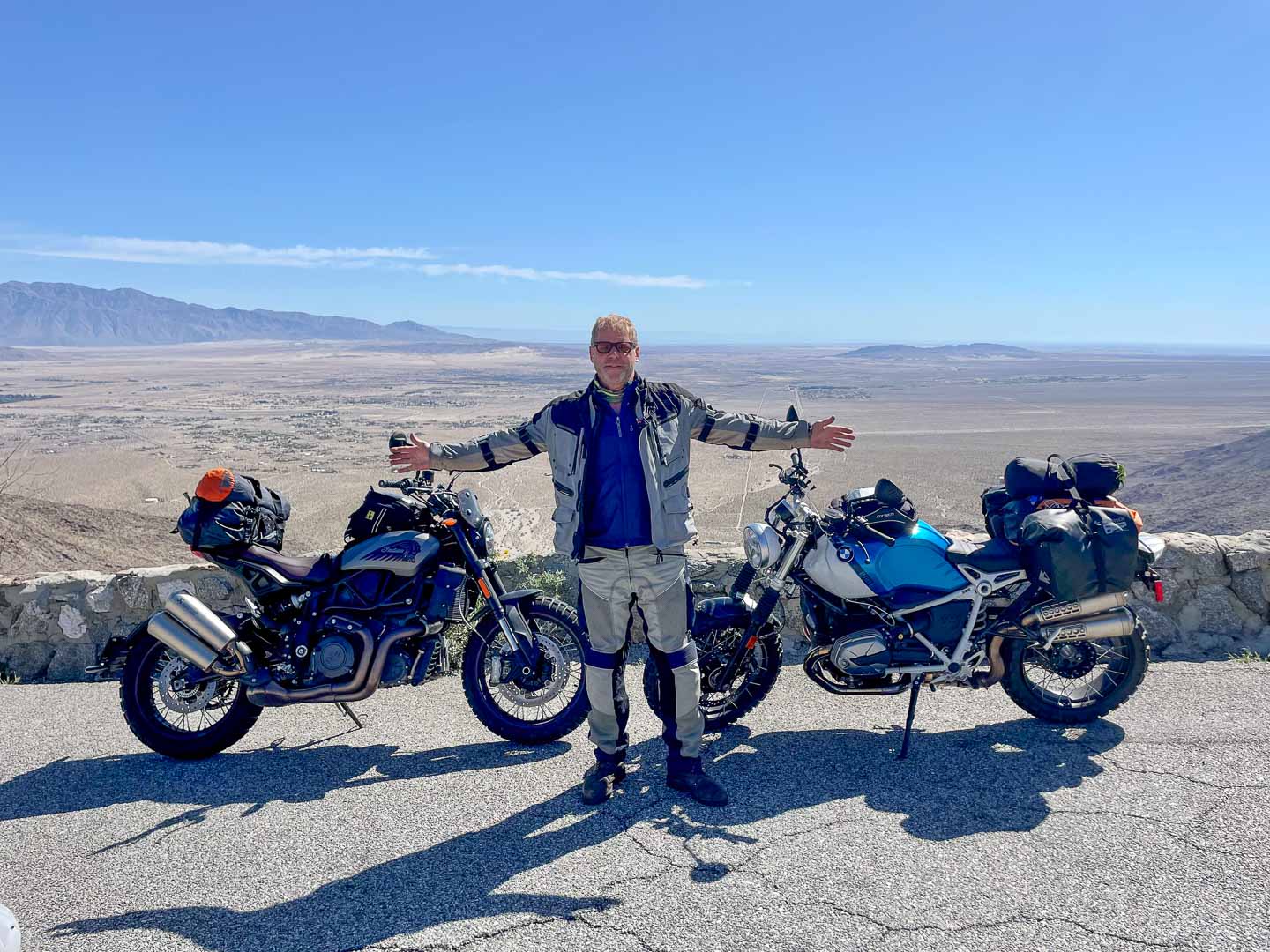
BMW R nineT Scrambler vs. Indian FTR Rally: Desert Scramble Tour
The forecast for the day in Flagstaff, as I sit 60 miles south for breakfast in Cottonwood, calls for snow. It is clear that the northerly route we had planned through Sedona wasn’t happening. I wondered what had happened to my dream of sipping cervezas and eating fish tacos on the beach. The original plan was a four-man Mexican Scramble—four buddies on four naked scrambler motorcycles bombing down the Baja peninsula from LA. Instead, we were down to a skeleton crew of two freezing our tails off in Northern AZ. Scramblers. They evoke the same images in my mind every time I see one. It is Steve McQueen or some equally crazed rider covered head-to-toe in sand and dirt, kicking up clouds of dust as they bomb along dry river beds or Mexican beaches on some modified 1960s street bike that had no earthly business tackling the stuff that was thrown at them. This uniquely American genre of bike screams “Freedom!” Scramblers pull at the soul of every rider who has fantasized about customizing an old street bike to tackle the desert with nothing but a backpack and sleeping bag. This has not been lost on motorcycle manufacturers, who have responded with a new generation of scrambler-style bikes.The idea was to test some of these modern scrambler motorcycles in the very environment that they were built for—pack light, camp where we could, and tackle asphalt, gravel, rocks, dirt, sand, and fish tacos all the way down the Baja Peninsula.As it turns out, getting test bikes to go to Mexico from the US wasn’t as easy as I thought—damn insurance companies. Then we lost a buddy to family obligations. So, we pivoted to three guys on scramblers in the deserts of the American southwest. While this wasn’t quite as cool-sounding as Mexico, at least sketchy Mexican fish tacos wouldn’t lead to an even sketchier camping situation.
Scramblers. They evoke the same images in my mind every time I see one. It is Steve McQueen or some equally crazed rider covered head-to-toe in sand and dirt, kicking up clouds of dust as they bomb along dry river beds or Mexican beaches on some modified 1960s street bike that had no earthly business tackling the stuff that was thrown at them. This uniquely American genre of bike screams “Freedom!” Scramblers pull at the soul of every rider who has fantasized about customizing an old street bike to tackle the desert with nothing but a backpack and sleeping bag. This has not been lost on motorcycle manufacturers, who have responded with a new generation of scrambler-style bikes.The idea was to test some of these modern scrambler motorcycles in the very environment that they were built for—pack light, camp where we could, and tackle asphalt, gravel, rocks, dirt, sand, and fish tacos all the way down the Baja Peninsula.As it turns out, getting test bikes to go to Mexico from the US wasn’t as easy as I thought—damn insurance companies. Then we lost a buddy to family obligations. So, we pivoted to three guys on scramblers in the deserts of the American southwest. While this wasn’t quite as cool-sounding as Mexico, at least sketchy Mexican fish tacos wouldn’t lead to an even sketchier camping situation.
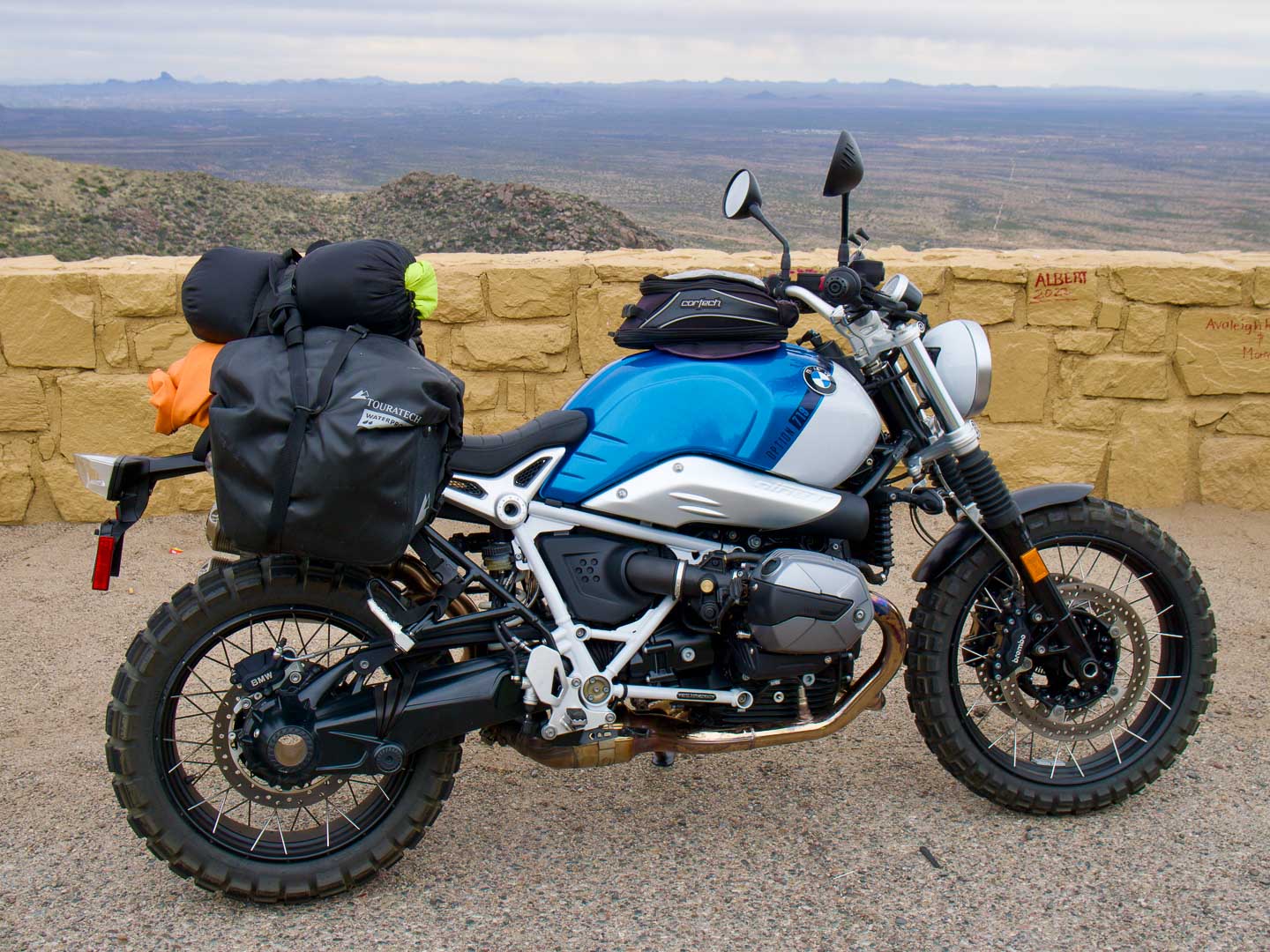
With our new plan set, we were able to secure two terrific loaner scramblers for the trip—a 2021 BMW R nineT Scrambler, with the Option 719 paint job and new 19-inch front and 17-inch rear Continental Twinduro TKC 80 tires, and a 2022 Indian FTR Rally with a 19-inch front and less-conventional 18-inch rear set up with Pirelli Scorpion STR tires. In addition, we had our buddy Alex’s own “McQueen Special” – his street bike converted to a scrambler.A week before departure, with camping and other essential travel gear packed and ready to go, our good friend COVID hit, taking Alex off the board—lost to quarantining. Well, we now had two loaner bikes and two riders—Beau Limbocker and me. Where others see coincidence, I see providence. Morpheus would be proud.We had six days, and our route was very fluid. We wanted to ride some desert terrain, cover some miles, and hit some fun canyons.The Beemer is a classic ride powered by the tried-and-true 1200cc air-/oil-cooled boxer engine. The R nineT definitely looks the part with its retro styling set up in scrambler style. The larger front hoop, beefy 50/50 tires, and high exhaust pipes make the R nineT Scrambler an ideal bike for our desert fun.

The (relatively) new kid on the block is the 1200cc Indian FTR (“flat track racer”). Indian introduced the bike in 2019 with a flat-tracker/scrambler vibe giving it a raucous engine, 19-inch front wheel, and semi-knobby tires. Indian revised the FTR after only a couple years, adding refinements to the engine and fueling, heat management, and pure-street 17-inch wheels to make it sportier and reduce the seat height. The company also extended the FTR into a range of models. Thankfully, they kept a Rally model that retained the 19-/18-inch wheel combo, grippier 50/50 tires, and none of IMU-informed electronic wizardry. I had ridden the new sportier bike with the 17-inch wheels and was very impressed with the bike. For this trip, we had to have the scrambler style of the Rally.We had two 1200cc twins with retro vibes decked out in desert wear that couldn’t be more different. Having owned boxer-driven motorcycles, I opted for the Indian to try something new. My riding buddy Beau grew up riding dirt bikes. He finds sandy washes and dirt roads are more comfortable than tight canyon carving. He had ridden a standard R nineT before and, while he liked the bike, the scrambled version was much more his style.Packing up the BMW and Indian was an interesting exercise. While these bikes scream “Adventure!” they have small seats and almost no space for gear. With a lot of ingenuity and bungee cords, we strapped six days of clothes and camping gear to the bikes. If touring and camping are your objectives on these bikes, opt for the accessory tail rack or aftermarket luggage mounting kits. Day One of riding was fantastic; Angeles Crest Highway was awesome, as usual. Fast and tight turns, long sweepers, epic vistas, and an empty road running the spine of the San Gabriel Mountains. After some great riding, we dropped down the back side to the desert. A few hours later, we arrived in Pioneertown in search of cold beer and campsites.It was Saturday night in early spring, which meant desert accommodations were not easy to find. We tried to find open camping down very sandy roads, but turned around when the loaded bikes got bogged down. We then tried a few out-of-the-way paid campsites—all were full. The exploration did give us a chance to cruise some sand and dirt back roads, which both scramblers handled well. With knobby-ish tires and good suspension travel, both motorcycles felt stable and predictable on the dirt and light sand, only becoming unsettled in the deeper washes.We ended up at a “campsite” in the dirt parking area in Pioneertown. The spot was pretty sketchy, but it did have the upside of being a short stumble away from the Red Dog bar, a locals bar with great Mexican food. We preferred it to the more well-known and crowded Pappy and Harriet’s Pioneertown Palace, which does triple duty as a restaurant, bar, and music venue—Paul McCartney played there in 2016.
Day One of riding was fantastic; Angeles Crest Highway was awesome, as usual. Fast and tight turns, long sweepers, epic vistas, and an empty road running the spine of the San Gabriel Mountains. After some great riding, we dropped down the back side to the desert. A few hours later, we arrived in Pioneertown in search of cold beer and campsites.It was Saturday night in early spring, which meant desert accommodations were not easy to find. We tried to find open camping down very sandy roads, but turned around when the loaded bikes got bogged down. We then tried a few out-of-the-way paid campsites—all were full. The exploration did give us a chance to cruise some sand and dirt back roads, which both scramblers handled well. With knobby-ish tires and good suspension travel, both motorcycles felt stable and predictable on the dirt and light sand, only becoming unsettled in the deeper washes.We ended up at a “campsite” in the dirt parking area in Pioneertown. The spot was pretty sketchy, but it did have the upside of being a short stumble away from the Red Dog bar, a locals bar with great Mexican food. We preferred it to the more well-known and crowded Pappy and Harriet’s Pioneertown Palace, which does triple duty as a restaurant, bar, and music venue—Paul McCartney played there in 2016.

Days Two and Three were a sprint to Arizona and back. Sedona and Arizona Highway 89A, from the Prescott Valley through Jerome, was calling our name. After a delicious breakfast of pancakes and egg scrambles at C&S Coffee Shop in nearby Yucca Valley, we departed.Temperatures were climbing fast, and we had 335 miles and a lot of desert to cross before the higher elevations of northern Arizona. We passed through 29 Palms, then bombed down the eastern half of California Highway 62, a 110-mile empty desert backroad, stopping at weird monuments and dusty small-town bars to cool down along the way.We crossed the Colorado River into Arizona at Parker, staying clear of Interstates and cruising at the slightly slower speeds of the backroads, which the naked bikes preferred. A strong crosswind was picking up and, with limited to no wind protection on these bikes, we had to hold on tight. After passing through several dusty small towns, we stopped at the Stamford Inn Cafe & Bar in Salome for the world’s coldest bottle of beer to get a respite from the heat and wind. Eventually, we picked up Highway 89 in Congress and started the climb into the mountains.
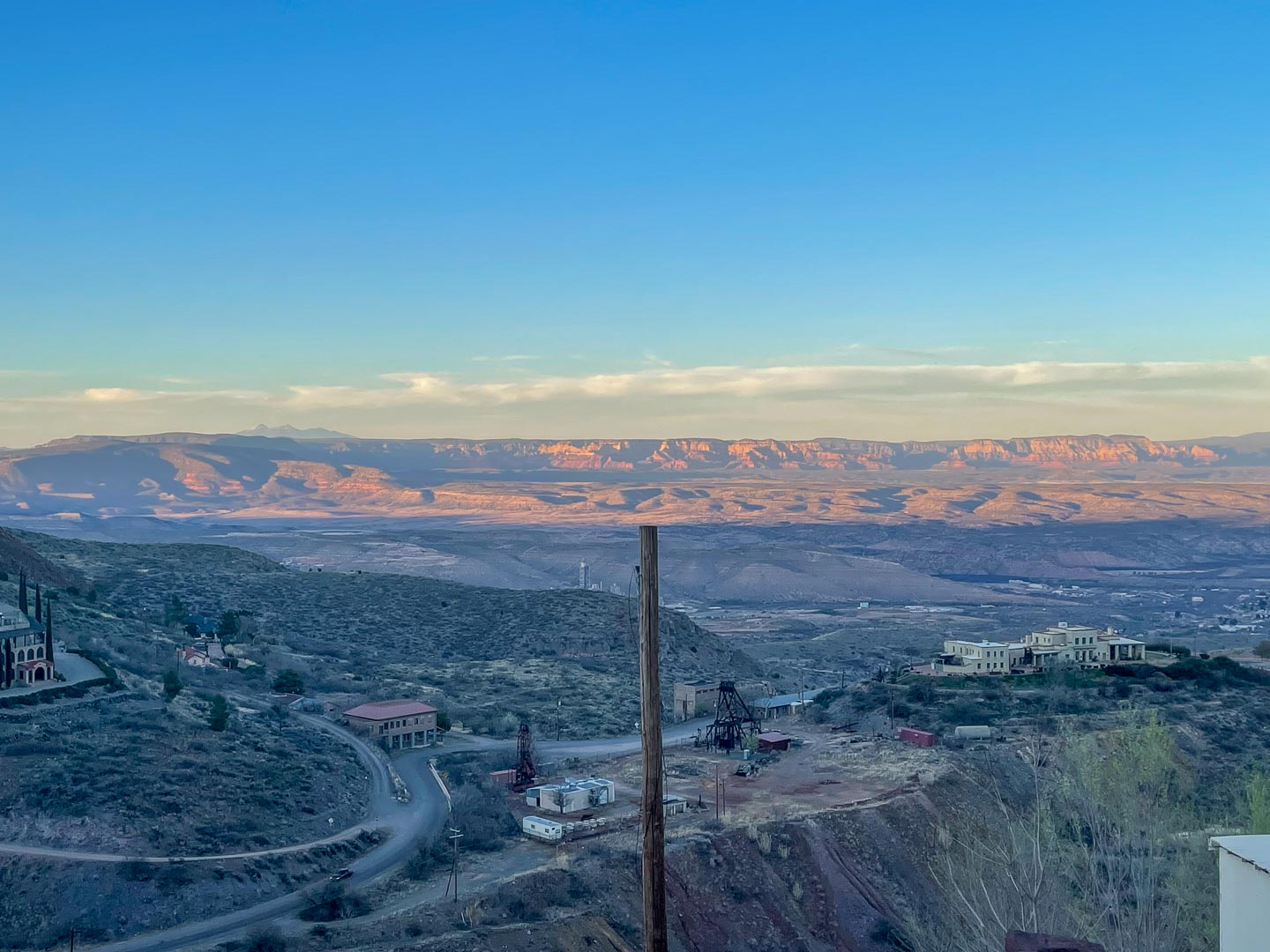
Highway 89 through the Prescott Valley and, especially, Highway 89A are a motorcyclist’s dream roads. The road curves and climbs up and dives down through beautiful mountains and valleys. We rode up through the haunted town of Jerome that clings precariously to the mountainside high above the desert floor. I have ridden through Jerome several times, and love the quaint and quirky feel, along with the fantastic views of the Verde Valley. We stopped at Bobby D’s for some BBQ and an epic view from the deck before riding down the mountain to end our day at the Iron Horse Inn in the small town of Cottonwood, strategically placed between Jerome and Sedona.The first two days of heat, wind, varying landscapes, and different road conditions provided a great introduction to the Indian FTR. Right out of the gate, the upright sitting position felt good, despite being pushed forward on the seat by all the gear I had strapped on the back. The footpeg position put my knees slightly bent back, which was not quite as comfortable as I would like, but the experience was not bad either. The Rally’s larger wheel diameters change the chassis’ geometry, making it feel more natural for me than the 17-inchers on the other FTR models. The first-generation FTR had some issues with engine heat. The new models have better cooling and airflow, as well as rear cylinder deactivation when stopped, combining to manage the heat effectively.The next morning, we scoured maps and weather reports to determine our next destination. A cold front was coming through, bringing rain in just about every direction. We had originally planned to go to Flagstaff through Sedona, but the forecast of rain (and snow!) changed our minds. We decided to skip Flagstaff and head to the more southernly Sedona, then turn back south to the warmth of the lower desert. On the way south, we climbed back up the mountain to Jerome and beyond. The steep, curvy roads demonstrated the FTR’s capabilities with the engine as the shining star. It is remarkably tractable, with fantastic power that isn’t too abrupt. The Rally’s V-twin power is available throughout the rev range and in almost any gear.The tight turns of 89A would normally require a lot of shifting and use of the second gear on most motorcycles. However, the FTR could run through the challenging turns in 3rd, 4th, or even 5th without a problem. When the road straightens out and speeds climb above 80 mph, there is still plenty of thrust for passing and to get you into the triple digits—not that we would do such a thing.Our destination for the day was Calexico, Calif., way down south, right on the border of Mexico—Mexicali is on the south side of the line. Beau grew up in South America, so I wanted to put his Spanish skills to the test. I wanted to find a dusty border town bar for us to get in some trouble.
On the way south, we climbed back up the mountain to Jerome and beyond. The steep, curvy roads demonstrated the FTR’s capabilities with the engine as the shining star. It is remarkably tractable, with fantastic power that isn’t too abrupt. The Rally’s V-twin power is available throughout the rev range and in almost any gear.The tight turns of 89A would normally require a lot of shifting and use of the second gear on most motorcycles. However, the FTR could run through the challenging turns in 3rd, 4th, or even 5th without a problem. When the road straightens out and speeds climb above 80 mph, there is still plenty of thrust for passing and to get you into the triple digits—not that we would do such a thing.Our destination for the day was Calexico, Calif., way down south, right on the border of Mexico—Mexicali is on the south side of the line. Beau grew up in South America, so I wanted to put his Spanish skills to the test. I wanted to find a dusty border town bar for us to get in some trouble.
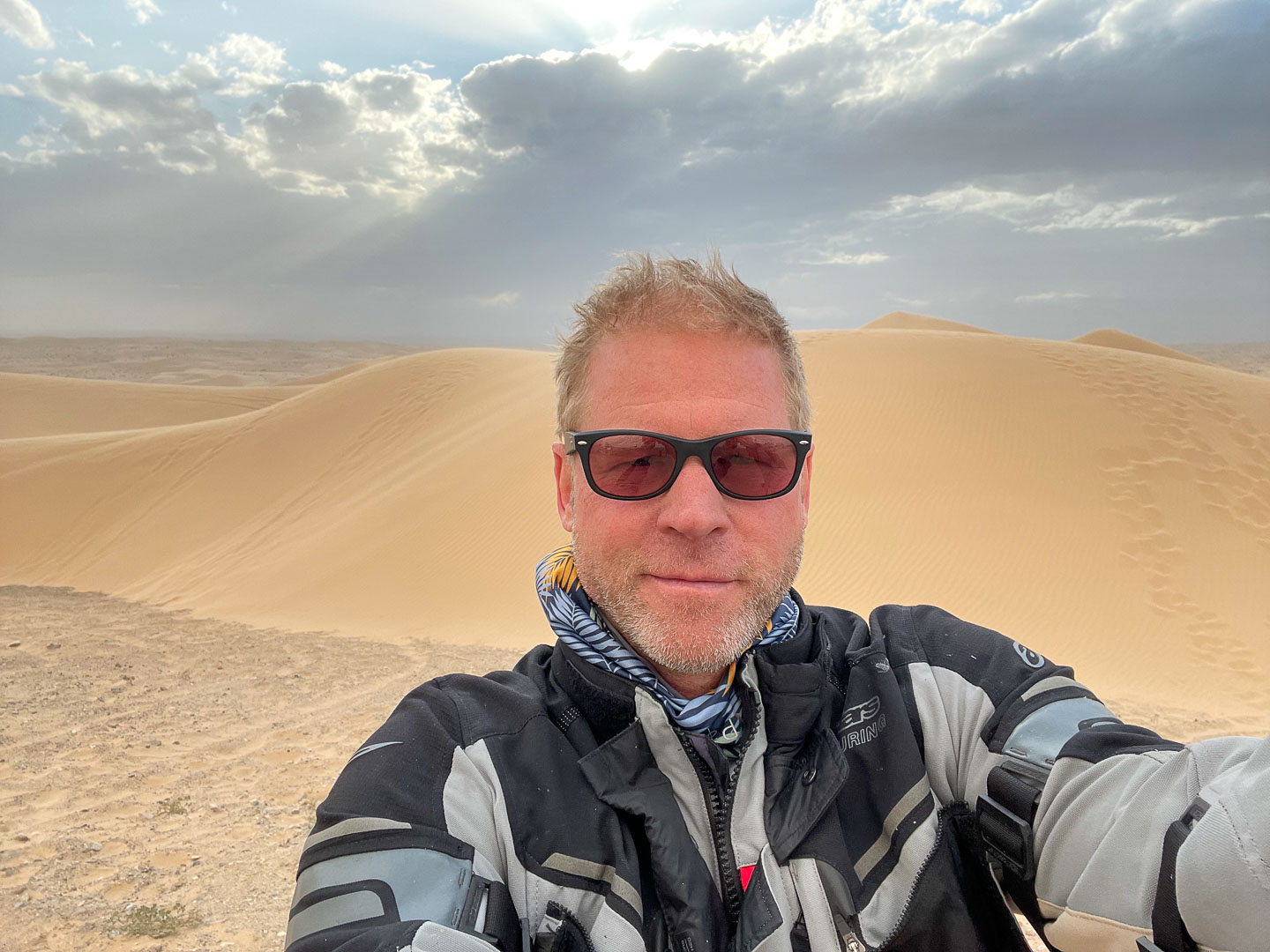
Our ride to Calexico took us through the Imperial Sand Dunes, which are unbelievable. It is just outside of Glamis, Calif., and the desert is like you’ve been transported to the Sahara. There are rolling sand dunes for as far as the eye can see. We had tossed around the idea of camping out there, but high winds from the cold front created an unpleasant sand-blasting effect, so we pushed on. Had we been there on Thanksgiving Weekend, there would have been literally hundreds of thousands of off-roaders gathered to ride the dune and party.With visions of a great night in a dusty border town bar drinking cold Mexican beer, we rolled into Calexico. My lack of research once again paid zero dividends. The only bar we found was at the Applebee’s restaurant next to the hotel. At least the Applebee’s provided some laughs when the bartender served us Jell-O shots!After “Eatin’ Good in the Neighborhood” and getting a good night’s sleep, Beau and I switched motorcycles and pointed them towards San Diego. As we pulled out of the parking lot, I noticed Beau’s rear tire was low. It turns out the FTR had a slow leak, and the tires are not tubeless, making my patch kit useless. I am not sure why any manufacturer puts tube tires on their bikes anymore, but there we were. Luckily, we were not far from Coyne Powersports in El Centro, where Genaro Ruiz and the service team set us right up with a patched tube. We were back on the road in no time. Thank you to the great guys at Coyne!Our destination for the day was Julian, with a detour through San Diego. The temperatures in the desert were great, but as we climbed up the coastal mountains, the temps fell fast! We stayed on Interstate 8 for a bit until we could find back roads to San Diego. At one point, the temperature dropped down to the mid-40s. Fortunately, the frigid conditions lasted for less than two hours.We had an incredible ride on old Highway 80 and Highway 94—both skirt along the Mexican border and through the mountains. The road climbed and dove through remarkably rural and empty terrain. At times, it felt as if we were transported to a remote back road in the Alps. I had never ridden in this area, and it is truly gorgeous.
Luckily, we were not far from Coyne Powersports in El Centro, where Genaro Ruiz and the service team set us right up with a patched tube. We were back on the road in no time. Thank you to the great guys at Coyne!Our destination for the day was Julian, with a detour through San Diego. The temperatures in the desert were great, but as we climbed up the coastal mountains, the temps fell fast! We stayed on Interstate 8 for a bit until we could find back roads to San Diego. At one point, the temperature dropped down to the mid-40s. Fortunately, the frigid conditions lasted for less than two hours.We had an incredible ride on old Highway 80 and Highway 94—both skirt along the Mexican border and through the mountains. The road climbed and dove through remarkably rural and empty terrain. At times, it felt as if we were transported to a remote back road in the Alps. I had never ridden in this area, and it is truly gorgeous. After a quick stop in San Diego, we bombed back up the coastal mountains to Julian. Again, the temps dropped, and some dense fog was thrown in our path. The cold air and the limited visibility made the ride up the mountains pretty intense. We stopped to thaw out and eat some great barbecue at the Julian Beer Company before wrapping up the day’s ride a couple of miles down the road at a very quiet and a weird little zen yoga hotel retreat. Beau and I nearly took out some deer and wild turkeys on the way to the hotel. Thankfully, there was a hot tub waiting at the end of the line, which was awesome because we were popsicles by the time we arrived.Spending the day on the BMW R nineT Scrambler, I discovered that it is light on its feet. The riding position on the Beemer is definitely different from the Indian. It feels like you are on top of the motorcycle rather than inside the cockpit. The wide fuel tank contributes to that feeling. The boxer engine spins up easily with gobs of torque, but that power fades much faster at higher revs than the FTR.A unique aspect of the boxer engine configuration is the torque that creates a wobble in the bike when the engine revs and the transmission disengaged. Standing still, you can feel it when you crack the throttle, and it seems to be more pronounced on the older air-cooled engines (like the one in the R nineT) than the newer water-cooled ones. Most of the time, this is just a quirk, but when downshifting through turns with the clutch lever in, it can feel a little disconcerting.
After a quick stop in San Diego, we bombed back up the coastal mountains to Julian. Again, the temps dropped, and some dense fog was thrown in our path. The cold air and the limited visibility made the ride up the mountains pretty intense. We stopped to thaw out and eat some great barbecue at the Julian Beer Company before wrapping up the day’s ride a couple of miles down the road at a very quiet and a weird little zen yoga hotel retreat. Beau and I nearly took out some deer and wild turkeys on the way to the hotel. Thankfully, there was a hot tub waiting at the end of the line, which was awesome because we were popsicles by the time we arrived.Spending the day on the BMW R nineT Scrambler, I discovered that it is light on its feet. The riding position on the Beemer is definitely different from the Indian. It feels like you are on top of the motorcycle rather than inside the cockpit. The wide fuel tank contributes to that feeling. The boxer engine spins up easily with gobs of torque, but that power fades much faster at higher revs than the FTR.A unique aspect of the boxer engine configuration is the torque that creates a wobble in the bike when the engine revs and the transmission disengaged. Standing still, you can feel it when you crack the throttle, and it seems to be more pronounced on the older air-cooled engines (like the one in the R nineT) than the newer water-cooled ones. Most of the time, this is just a quirk, but when downshifting through turns with the clutch lever in, it can feel a little disconcerting.
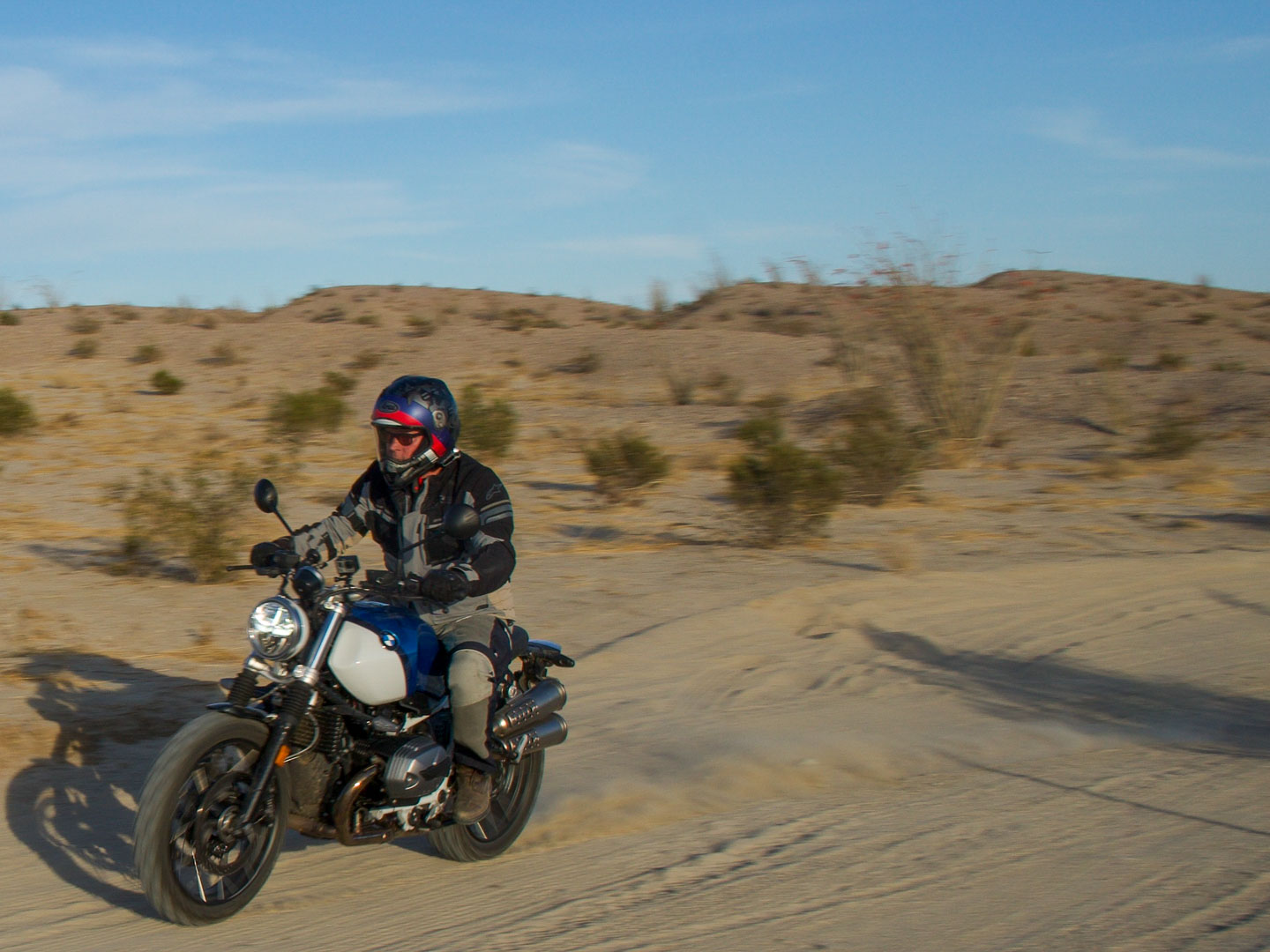
The final destination before heading home was Borrego Springs, a short ride from Julian. We took the back way in, following Highway 79 to San Felipe Road and then Montezuma Valley Road, which offers amazing twisty roads and epic desert vistas. I was back on the FTR and enjoying it thoroughly. In addition to that sweet engine, the suspension soaked up the road imperfections and delivered predictably confidence-inspiring poise through the turns.We decided to camp one more night at the Anza-Borrego Desert State Park. After securing a site, we unloaded all the gear and set up tents. Pro tip: try to reserve a site on the outer ring facing out, as they are more private than the inner sites. Once camp was set, we took the unladen machines out to explore.

We found plenty of sandy dirt roads to test the scrambling capabilities, and a cool slot canyon to hike. Both bikes handled the sandy roads well, with the BMW’s suspension feeling a bit more composed and quieter than the Indian’s, which made some weird noises on the bumpier sections. Neither bike would be great if the terrain turned more technical.After a nice night under the stars, we packed up and headed back towards Los Angeles with a final stop in Temecula to sample great wine.
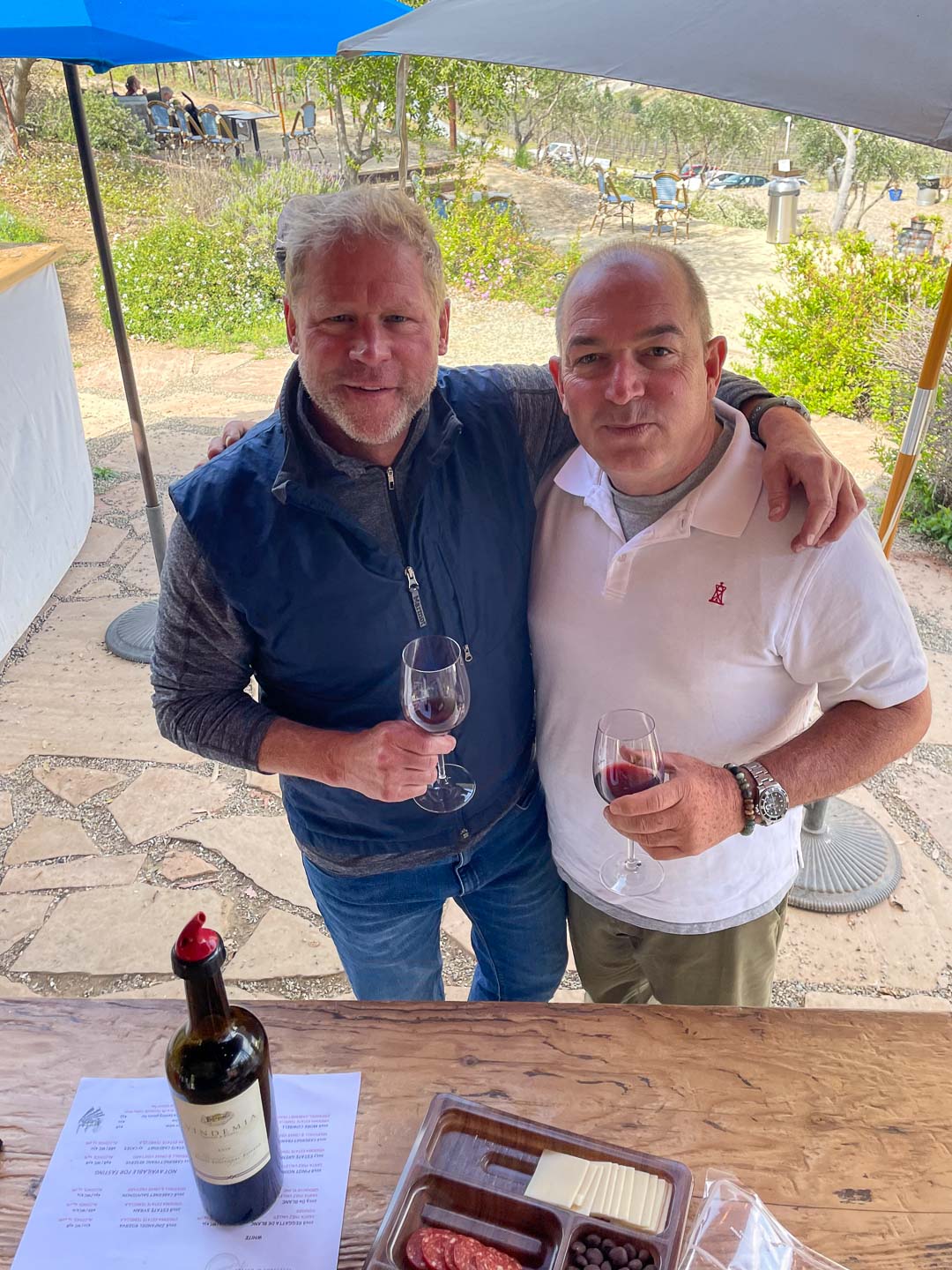
Both motorcycles turned out to be great choices for the trip with a few drawbacks. The Indian edged out the BMW for me. However, the FTR was always the bike first out of gas, it has a slightly more comfortable seat, and a little less bend in the leg for my six-foot frame. Beau was won over by the BMW after initially loving the Indian, though he wasn’t as happy about the boxer’s torque steering.Neither the BMW R nineT Scrambler nor the Indian FTR Rally was designed for touring, but that didn’t deter us. We were very pleased with both machines and felt a connection to the road and the journey that is lacking in touring motorcycles with big windscreens and extensive creature comforts.Photography by Beau Limbocker and Freeman Wood
| SPECS COMPARISON | BMW R nineT Scrambler | Indian FTR Rally |
| ENGINE | ||
| Type | Horizontally opposed twin w/ counterbalancer | 60-degree V-twin |
| Displacement | 101 x 73mm | Displacement 1203cc |
| Bore x stroke | 1170cc | 102 x 76.3mm |
| Maximum power | 109 horsepower @ 7250 rpm | 123 horsepower @ 7750 rpm |
| Maximum torque | 85 ft-lbs @ 6000 rpm | 87 ft-lbs @ 6000 rpm |
| Compression ratio | 12.0:1 | 12.5:1 |
| Valvetrain | DOHC; 4vpc | DOHC; 4vpc |
| Transmission | 6-speed | 6-speed |
| Clutch | Single dry plate w/ hydraulic actuation | Wet multiplate w/ assist and slipper functions |
| Final drive | Shaft | 525 chain |
| CHASSIS | ||
| Frame | Three-section w/ load-bearing engine | Trellis |
| Front suspension; travel | Non-adjustable 43mm forks; 4.9 inches | Non-adjustable inverted 43mm cartridge fork; 5.9 inches |
| Rear suspension; travel | Non-linkage, rebound-damping and spring-preload adjustable shock; 5.5 inches | Non-linkage, spring-preload and rebound-damping adjustable shock; 5.9 inches |
| Wheels | Cast aluminum | Wire-spoke |
| Front | 19 x 3 | 19 x 3 |
| Rear | 17 x 4.50 | 18 x 4.25 |
| Tires | Continental Twinduro TKC 80 (optional) | Pirelli Scorpion Rally STR |
| Front tire | 120/70 x 19 | 120/70 x 19 |
| Rear tire | 170/60 x 17 | 150/70 x 18 |
| Front brakes | 320mm discs w/ 4-piston Brembo calipers | 320mm discs w/ 4-piston Brembo calipers |
| Rear brake | 265mm disc w/ 2-piston floating caliper | 265mm disc w/ 2-piston Brembo caliper |
| ABS | BMW Motorrad ABS Pro | Standard |
| DIMENSIONS and CAPACITIES | ||
| Wheelbase | 60.1 inches | 60 inches |
| Rake | 28.5 degrees | 26.3 degrees |
| Trail | 4.4 inches | 5.1 inches |
| Seat height | 32.3 inches | 33.1 inches |
| Fuel capacity | 4.5 gallons | 3.4 gallons |
| Curb weight | 492 pounds | 529 pounds |
| Color | Option 719 Cosmic Blue Metallic/Light White (+$590) | Titanium Smoke |
| Price/MSRP | $13,594 (base model) | $13,999 MSRP |
Desert Scramble Photo Gallery
